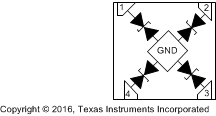SLVSBG0E August 2012 – April 2016 TPD4E101
PRODUCTION DATA.
- 1 Features
- 2 Applications
- 3 Description
- 4 Revision History
- 5 Pin Configuration and Functions
- 6 Specifications
- 7 Detailed Description
- 8 Application and Implementation
- 9 Power Supply Recommendations
- 10Layout
- 11Device and Documentation Support
- 12Mechanical, Packaging, and Orderable Information
Package Options
Mechanical Data (Package|Pins)
- DPW|4
Thermal pad, mechanical data (Package|Pins)
- DPW|4
Orderable Information
7 Detailed Description
7.1 Overview
The TPD4E101 is a four-channel ESD TVS diode protection device. The device offers ±15-kV IEC air-gap, ±15-kV contact ESD protection. Each channel has a back-to-back TVS diode to support bipolar or bidirectional signal. This device allows a wide range of applications supporting data rates up to 700 Mbps with the 4.8-pF typical line capacitance. The package is compact and convenient for component placement in space-constrained applications. The 0.48-mm pitch helps save on PCB manufacturing costs.
Typical interfaces that can be protected by TPD4E101 are SIM cards, audio lines (microphones, earphones, and speakerphones), SD interfaces, and push-buttons. The TPD4E101 is good for providing protection in end-equipment like cell phones, portable media players, wearables, set-top boxes, and eBooks.
7.2 Functional Block Diagram

7.3 Feature Description
The TPD4E101 is a four-channel bidirectional TVS device with high ESD protection level. This device provides a very robust protection from ESD strikes up to ±15-kV contact and ±15-kV air-gap specified in the IEC 61000-4-2 level 4 international standard. The device can also handle up to 3-A surge current (IEC61000-4-5 8/20 µs). The typical I/O capacitance of 4.8 pF supports a data rate up to 700 Mbps. This clamping device has a small dynamic resistance of 0.45 Ω typically. This makes the clamping voltage low when the device is actively protecting other circuits. For example, the clamping voltage is only 10 V when the device takes 1-A surge current. The small package makes it a great protection option for personal electronics applications like SIM cards and SD interfaces. The breakdown is bidirectional so that it is also a good fit for bidirectional signal applications like audio lines. Ultra-low leakage allows the diode to conserve power in the normal voltages. The industrial temperature range of –40°C to +125°C makes this ESD device work at extensive temperatures in most environments.
7.4 Device Functional Modes
The TPD4E101 is a four-channel passive clamps device that has low leakage during normal operation when the voltage between the ESD-protected channels and GND is within the range of –5.5 V to 5.5 V and activates when it goes out of the range. During IEC ESD events, transient voltages as high as ±15 kV can be clamped between the ESD protected channels and GND pin. When the voltages on the protected lines fall within the trigger range, the device reverts back to the low-leakage passive state.